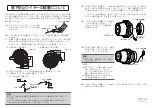
Handbook for the SXV-M25C Issue 1 June 2004
13
and you may like to try them before applying any image enhancement with the
software. However, there will come a point when you say, “That’s the best that I can
get” and you will want to experiment with the effects of image processing. In the case
of daylight images, the processing options are many, but there are few that will
improve the picture in a useful way. The most useful of these are the ‘Normal
Contrast Stretch’, ‘Power law stretch’ and the ‘High Pass Low Power’ filter.
The ‘Contrast’ routines are used to brighten (or dull) the image highlights and
shadows. A ‘Normal’ stretch is a simple linear operation, where two pointers (the
‘black’ and ‘white’ limits) can be set at either side of the image histogram and used to
define new start and end points. The image data is then mathematically modified so
that any pixels that are to the left of the ‘black’ pointer are set to black and any pixels
to the right of the ‘white’ pointer are set to white. The pixels with values between the
pointers are modified to fit the new brightness distribution. Try experimenting with
the pointer positions until the image has a pleasing brightness and ‘crispness’. Most
daylight pictures suffer from having too much ‘Gamma’ (a way of referring to the
contrast response curve) and look unnaturally contrasty. Applying a ‘Power law’
stretch of about 0.5 power will often make them look better, although you will
probably need to follow this with a ‘Normal’ stretch to darken the shadow regions.
The high pass filter gives a moderate improvement in the image sharpness, and this
can be very effective on daylight images. Too much high pass filtering results in dark
borders around well-defined features and will increase the noise in an image to
unacceptable levels, but the Low Power filter is close to optimum and gives a nicely
sharpened picture, as above.
At this point, you will have a working knowledge of how to take and process an SXV-
M25C image. It is time to move on to astronomical imaging, which has its own
unique set of problems!
*********************************************************************
Astronomical Imaging with the SXV-M25C
1)
Getting the image onto the CCD:
The SXV-M25 has a very large CCD chip and this will not work well with many
commonly available telescopes, such as Schmidt-Cassegrain and Newtonian
reflectors. At the very least, the corners of the image will be severely vignetted by the
narrow optical path and you are likely to see just a round ‘porthole’ in the middle of
the image field. As you are the owner of an M25, I am assuming that you already
have a suitable optical system available, but as a general guideline, a short focus
apochromatic refractor is an ideal choice. Many of these are expensive, but are
essential if you are to achieve top quality results. I use a Takahashi FSQ106 (106mm
aperture, 500mm focal length), but the Sky90 and Televue NP101 are other excellent
choices. You need a well corrected flat field which has been designed to cover at least
a 35mm film frame – preferably a 57mm format frame. Some high quality camera
lenses will give good results, but many of these have poor infra-red and UV
correction that can cause halos around bright stars and result in soft images. An
IR/UV blocking filter can help a great deal, at some cost to sensitivity, and the IDAS
light pollution rejection filter will perform this task very well. I recommend the IDAS














































